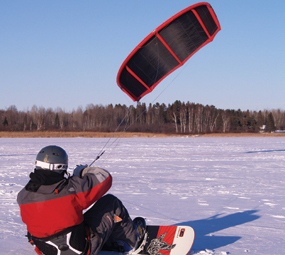Go Fly a Kite
It’s a clear winter day with five inches of fresh powder blanketing a large frozen lake. The wind is blowing from the Southwest at 16-20 mph. At first a single ten-square-meter kite appears, but as the afternoon progresses a collection of kites and riders have gathered. Bright kites are swinging through the air as riders on alpine skis and snowboards glide along on their crosswind, edging deep into the snow as the kites pull and lift. The color and movement are so visually compelling that cars are now pulling over on the shoulder of the road to observe this unique interaction with the natural force of the wind.

There is one thing that I know for sure. Once you get into it, snow kiting becomes an absolute obsession. The equipment design, environmental awareness, skill development, acceleration and weightlessness all combine to make this adventure sport very appealing. It’s a very technical sport that offers many rewards.
The concept behind snow kiting is fairly basic – harness wind power in a large controllable kite to propel yourself across the snow or ice while riding a snowboard, alpine skis or even skates.
Kites come in many sizes for use in specific wind conditions and are designed with open cell foils or inflatable chambers. Equipment consists of a kite, lines, control bar, harness and helmet. Winter is the best time to learn the basics of snow kiting. The skills learned on the snow are very useful for those who pursue kiting on the water.
A typical LEVEL I – Introduction Session on the University of Minnesota Duluth campus starts with the following topics over a two hour time span:
- kite design, wind prediction, site assessment, preparing the kite, identifying safety features, defining the wind window and safety zones
- learn control bar skills that steer the kite prior to and after it’s launched
- split into pilot and assistant roles to prepare a kite for launch outdoors
- lower the kite in the neutral position and re-launch the kite process
- fly figure-eight patterns, power stroke and loop patterns to demonstrate control
- one hand piloting and two hand power lifts from lying to standing position
- work on flying a quiet kite and then do running reaches to the left or right
- land and stow the two line kite properly to avoid line tangles
- observe a solo de-power and re-launch demonstration
- if skills allow try basic jumping patterns and make a land-board reach across the field
The following sessions are designed to increase skills at every level – launch site skills, destination kiting, reliable up-wind travel and lake exploration using multiple kites, and finally terrain park exploration, jumping and self expression.
Snow kiting apeals to a wide range of ages from teens to adults to retirees. Being able to pilot the kite with precision is really the key to managing the power that you get from the wind. As you advance your piloting skills to an instinctual level things get easier. It’s like you have become the water skier and the boat driver all rolled into one.





